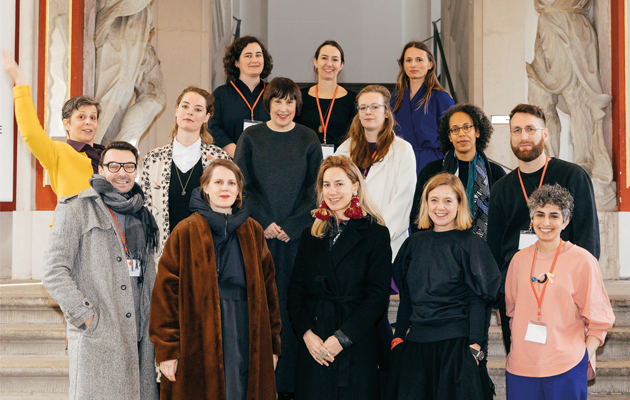 ‘A Woman’s Work’, a symposium in Dresden for the ‘Against Invisibility’ exhibition. Photo by David Pinzer
‘A Woman’s Work’, a symposium in Dresden for the ‘Against Invisibility’ exhibition. Photo by David Pinzer
On International Women’s Day, Vera Sacchetti and Matylda Krzykowski of Foreign Legion call for women in design to find strength in numbers to change the industry
For female design practitioners in the early 21st century, the opening two decades have brought attention – and, with attention, visibility. This renewed interest in the role of women helps to counter design history’s systematic erasure of their presence. While there is reason to cheer, why stop there? This is an important moment, charged with possibilities to bring about overdue change, with consequences that will benefit not only women, but all those who fight for equality.
As women step into the spotlight, myths and long-standing beliefs within design can be shattered. The lone genius, the heroic creator, the idea (and object) that arrives fully formed – all of these can be challenged and the discipline can finally re-evaluate all its messy complexity, its collaborative nature, and non-linear processes. And in this effort, the design discipline can allow itself to be deeply transformed. This is how the yin revolution – a poetic concept outlined by author Ursula K LeGuin in her series of essays No Time to Spare – starts.
No longer need women strive to navigate the design profession without role models to be inspired by. No longer need women conform to any predefined career orientation, instead designing their paths in whichever way they deem best. And because, in recent years more than ever, women in design can find inspiring examples all around them, the practitioner of today should not have to quiet down their voice, hush away their presence, or hide their influence.
At present, most of our attention should be given to claiming space and agency in design: finding and using our own voices, loud and clear to say things such as:
Yes, grant me that opportunity.
Yes, I want access to that platform.
Yes, give me that job (and pay me as much as you would a man).
Yes, represent and sell my work (for the same price as you sell a work by a man).
Yes, this is obvious, necessary, and the only way I will work for you, with you, alongside you.
Speaking loud and clear is fundamental, but not every woman does this. Why? Partly, because of the structures that are in place at the moment. To this day, women in design have mainly been educated by men (in classes where half the students – if not more – are female); hired by men; working for men; and their work has been valued, collected (and exhibited, or not) by men.
If women cannot change how they are perceived by others, professional opportunities alone will never be enough. The creation of discursive environments where change can be enacted, tested out, then replicated and amplified, can only happen if and when women in design start using their voices. And by finding strength in numbers, they can finally advocate for equality in order to ultimately dismantle existing conditions.
On 18 January this year, we made our first attempt to dismantle such structures, organising a collaborative conversation at the Museum of Applied Arts in Dresden. Titled A Woman’s Work, the event gathered voices from the discipline of design to discuss the roles and influence of female practitioners. The symposium took place alongside the exhibition Against Invisibility, which rewrote a fraction of modern design history by rescuing the nearly-forgotten stories of female designers working in the Deutsche Werkstätten Hellerau in the early decades of the 20th century.
What are the differences between them and us? As design critic Alice Rawsthorn pointed out in the symposium, ‘we need to build on [past achievements] with a dynamic and critical discourse … While many skirmishes have been won, others await.’
We must ensure that our stories won’t get lost like theirs. We must create spaces for their – and our – voices to be heard once the present generation is long gone. We must ensure that the current enthusiasm doesn’t get lost, and after an object designed by a woman is sold, exhibited, commissioned and exchanged for inflated sums of money, women – and their stories – will remain.
It is the responsibility of the gatekeepers – who write, who teach, who collect, who curate, who sell, who promote, who advocate – to open the gates for the dismantling of past and present conditions, in order to make women’s work, contributions and visibility a permanent condition.
What does the revolution bring with it? We do not know. But we know it is thorny, messy, complex and collaborative. It starts with simple actions. It begins with adding to the canon of design history voices other than those of white men; promoting and investing in work made by practitioners other than white men. It involves revamping design education to elect new role models and rewriting your syllabus to include more diverse voices. When prompted, it involves selecting someone other than a white man for a panel. It involves selecting a diverse group of people in the next exhibition you curate. It means working with someone other than those whom you already know.
These are the ways in which we can continue to claim space, connect people, and enact transformation. And this will transform us all.
This article originally appeared in Icon 190, the April 2019 issue.















